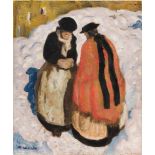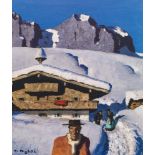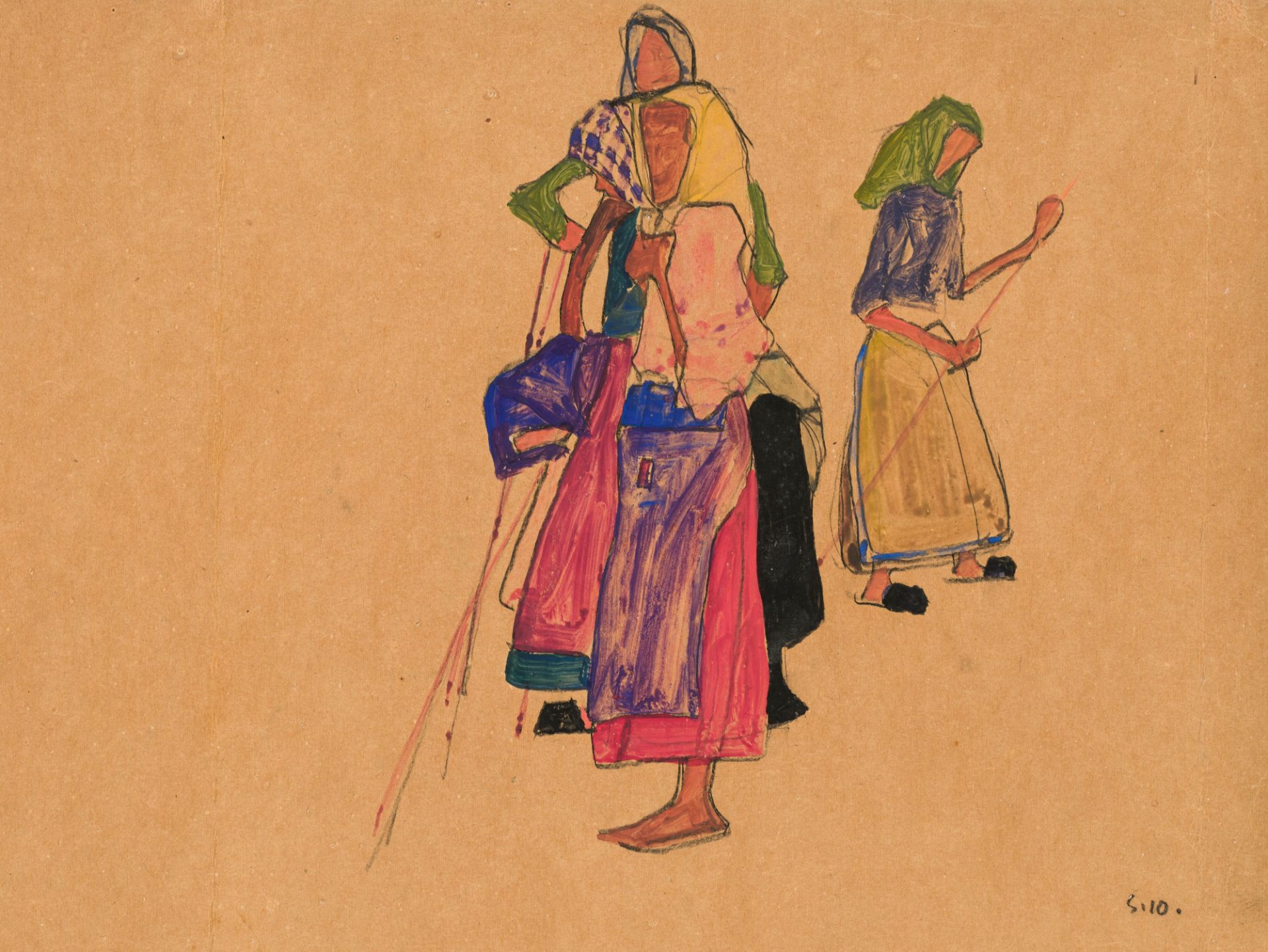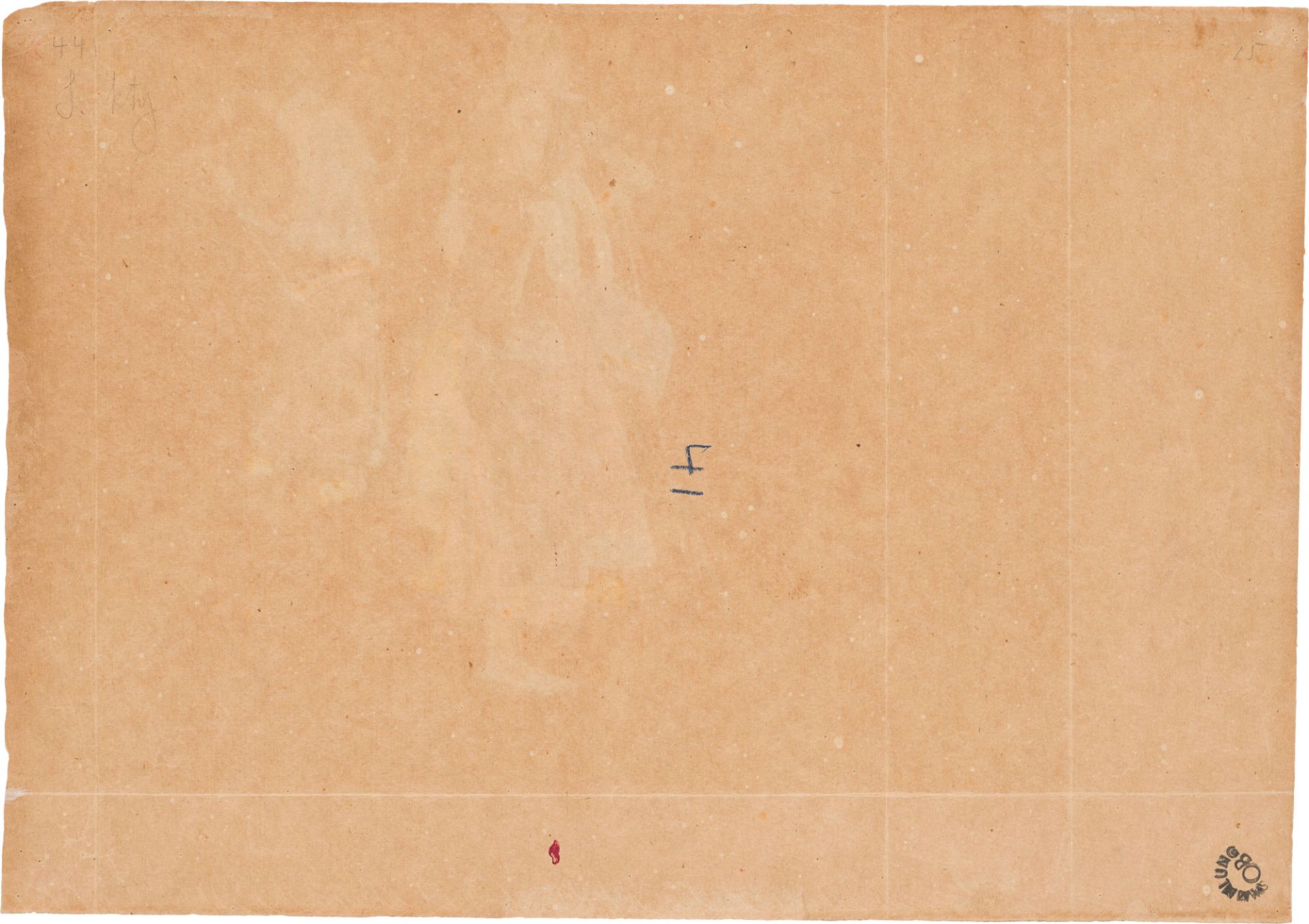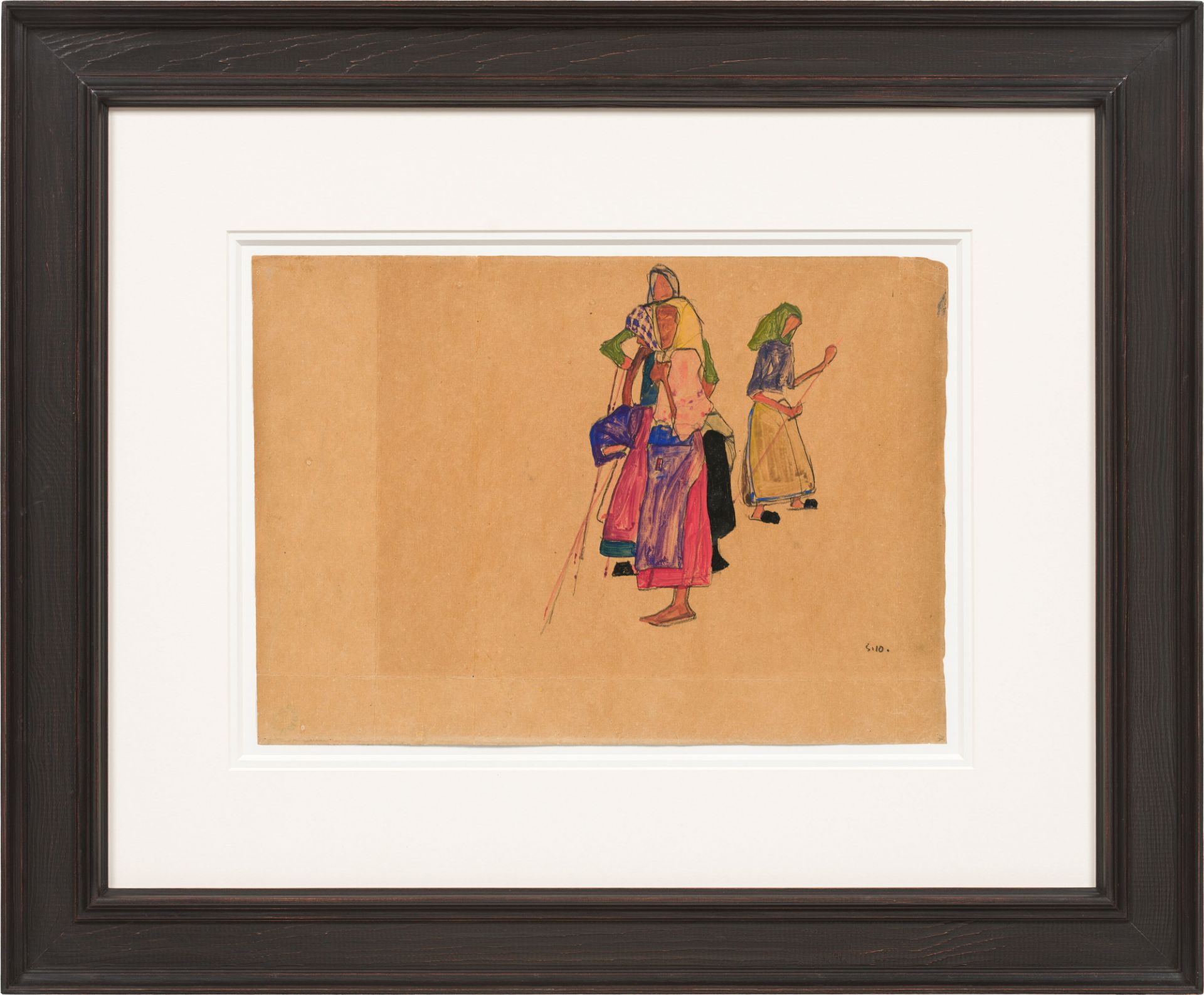3
Egon SchieleBäuerinnen1910gouache, watercolour, black crayon on paper; framed31.2 x 44.5
Egon Schiele
Bäuerinnen
1910
gouache, watercolour, black crayon on paper; framed
31.2 x 44.5 cm
monogrammed and dated on the lower right: S.10.
collector's stamp Otto Brill on the reverse
collection Otto Brill, Vienna and London (verso with collector's mark, Frits Lugt 2005a);
Galerie 10, Vienna;
Galerie Würthle, Vienna,
acquired from the above in 1986, since then private property, Austria
1974 Vienna, Galerie 10, Landschaft in der Kunst, January;
1986 Vienna, Galerie Würthle, Klimt, Schiele, Ensor, Kubin, 25.04.-07.06., no. 3
Jane Kallir, Egon Schiele. The Complete Works, New York 1998, no. D. 725, b/w-ill. p. 430
The period around 1910 was a time full of upheavals and the first successes for the young Egon Schiele. In 1909, he left the Academy of Fine Arts in Vienna after only three years and founded the "Neukunstgruppe" ("New Art Group") with like-minded artists, including his later brother-in-law Anton Peschka, Rudolf Kalvach and Erwin Osen. In that same year, he also met the doyens of the Austrian art scene of the time, Josef Hoffmann and Gustav Klimt, who enabled him to exhibit his work at the "Kunstschau 1909". Even though the situation seemed to be developing very favourably for Egon Schiele, in May 1910 he turned his back on Vienna and moved to Krumau in southern Bohemia, then still part of Austria.
The work "Bäuerinnen" ("Farm Women") by Egon Schiele, who was just 20 years old, was probably painted in that very town. The artist has depicted four women wearing headscarves, colourful dresses and aprons, in a tightly interlocked group in a triangular composition. The harmonious arrangement of the women is thrown off balance by a fifth farm woman who is moving off to the side. Long sticks in the women’s hands suggest that they are herding geese. What is striking is that even though their faces are only vaguely suggested, their eyeless gazes are nonetheless impressively intense. By depriving them of individual facial features, Egon Schiele relegates his farm women to anonymity. The contours of the women and their clothes are delineated with sure black chalk lines and their outlines are filled in with strong colours in a combination of vibrant opaque gouache and delicately glazed watercolour technique. The colours, set in deliberate contrast with one another, already have a powerfully expressive character. Another striking feature is the combination of the dense group of figures with the complete emptiness of the left half of the canvas. This makes the figures appear lost, as if abandoned – an effect that may have irritated the former owners, as the work was for a long time shown in such a way that only the more crowded half of the picture could be seen. Yet it is precisely this abstract nothingness with which Egon Schiele confronts his figures that elevates the picture to a higher existential plane.
(Sophie Cieslar)
Egon Schiele
Bäuerinnen
1910
Gouache, Aquarell, schwarze Kreide auf Papier; gerahmt
31,2 x 44,5 cm
Monogrammiert und datiert rechts unten: S.10.
Rückseitig Sammlungsstempel Otto Brill
Sammlung Otto Brill, Wien und London (verso mit Sammlerstempel, Frits Lugt 2005a);
Galerie 10, Wien;
Galerie Würthle, Wien,
dort 1986 erworben, seither österreichischer Privatbesitz
1974 Wien, Galerie 10, Landschaft in der Kunst, Jänner;
1986 Wien, Galerie Würthle, Klimt, Schiele, Ensor, Kubin, 25.04.-07.06., Nr. 3
Jane Kallir, Egon Schiele. The Complete Works, New York 1998, Nr. D. 725, s/w-Abb. S. 430
Die Jahre um 1910 sind für den jungen Egon Schiele eine Zeit voller Umbrüche und ersten Erfolgen. 1909 verlässt er nach nur drei Jahren die Akademie der bildenden Künste in Wien und begründet mit Gleichgesinnten, darunter sein späterer Schwager Anton Peschka, Rudolf Kalvach und Erwin Osen, die "Neukunstgruppe". Im selben Jahr lernt er auch die Doyens der damaligen österreichischen Kunstszene, Josef Hoffmann und Gustav Klimt, kennen, der es ihm ermöglicht auf der "Kunstschau 1909" auszustellen. Trotzdem sich die Situation für Egon Schiele günstig zu entwickeln scheint, kehrt er Wien den Rücken und übersiedelt im Mai 1910 ins südböhmische Krumau, damals noch Teil Österreichs.
Das Werk "Bäuerinnen" des gerade 20-jährigen Egon Schiele entsteht vermutlich bereits ebendort. Der Künstler hat vier kopftuchtragenden Frauen mit bunten Gewändern und Schürzen in einer eng verschachtelten Gruppe in Dreieckskomposition dargestellt. Die harmonische Anordnung der Frauen wird durch eine fünfte Bäuerin aus dem Gleichgewicht gebracht, die sich seitlich wegbewegt. Lange Stecken in den Händen der Frauen deuten darauf hin, dass es sich um Gänsemägde handelt. Auffallend sind die nur schemenhaft angedeuteten Gesichter, deren augenlose Blicke dennoch beeindruckend intensiv sind. Ihrer individuellen Gesichtszüge beraubt, verbannt Egon Schiele seine Mägde in die Anonymität. Die Konturen der Frauen und ihrer Gewänder sind mit sicheren, schwarzen Kreidelinien gezogen und die so gewonnenen Binnenformen mit starken Farben in einer Kombination aus leuchtend-deckender Gouache- und zartlasierender Aquarelltechnik befüllt. Die zueinander bewusst in Kontrast gesetzten Farben haben bereits stark expressiven Charakter. Auffallend ist auch die Kombination der dichten Figurengruppe mit der kompletten Leere der linken Blatthälfte. In diesem Zusammenhang wirken die Figuren verloren, wie ausgesetzt. Ein Umstand der frühere Besitzer irritiert haben mag, wurde die Arbeit doch längere Zeit so präsentiert, dass nur die dichte Bildhälfte zu sehen war. Aber gerade dieses abstrakte Nichts mit dem Egon Schiele seine Figuren konfrontiert, hebt die Darstellung in eine höhere, existentielle Ebene.
(Sophie Cieslar)
Egon Schiele
Bäuerinnen
1910
gouache, watercolour, black crayon on paper; framed
31.2 x 44.5 cm
monogrammed and dated on the lower right: S.10.
collector's stamp Otto Brill on the reverse
collection Otto Brill, Vienna and London (verso with collector's mark, Frits Lugt 2005a);
Galerie 10, Vienna;
Galerie Würthle, Vienna,
acquired from the above in 1986, since then private property, Austria
1974 Vienna, Galerie 10, Landschaft in der Kunst, January;
1986 Vienna, Galerie Würthle, Klimt, Schiele, Ensor, Kubin, 25.04.-07.06., no. 3
Jane Kallir, Egon Schiele. The Complete Works, New York 1998, no. D. 725, b/w-ill. p. 430
The period around 1910 was a time full of upheavals and the first successes for the young Egon Schiele. In 1909, he left the Academy of Fine Arts in Vienna after only three years and founded the "Neukunstgruppe" ("New Art Group") with like-minded artists, including his later brother-in-law Anton Peschka, Rudolf Kalvach and Erwin Osen. In that same year, he also met the doyens of the Austrian art scene of the time, Josef Hoffmann and Gustav Klimt, who enabled him to exhibit his work at the "Kunstschau 1909". Even though the situation seemed to be developing very favourably for Egon Schiele, in May 1910 he turned his back on Vienna and moved to Krumau in southern Bohemia, then still part of Austria.
The work "Bäuerinnen" ("Farm Women") by Egon Schiele, who was just 20 years old, was probably painted in that very town. The artist has depicted four women wearing headscarves, colourful dresses and aprons, in a tightly interlocked group in a triangular composition. The harmonious arrangement of the women is thrown off balance by a fifth farm woman who is moving off to the side. Long sticks in the women’s hands suggest that they are herding geese. What is striking is that even though their faces are only vaguely suggested, their eyeless gazes are nonetheless impressively intense. By depriving them of individual facial features, Egon Schiele relegates his farm women to anonymity. The contours of the women and their clothes are delineated with sure black chalk lines and their outlines are filled in with strong colours in a combination of vibrant opaque gouache and delicately glazed watercolour technique. The colours, set in deliberate contrast with one another, already have a powerfully expressive character. Another striking feature is the combination of the dense group of figures with the complete emptiness of the left half of the canvas. This makes the figures appear lost, as if abandoned – an effect that may have irritated the former owners, as the work was for a long time shown in such a way that only the more crowded half of the picture could be seen. Yet it is precisely this abstract nothingness with which Egon Schiele confronts his figures that elevates the picture to a higher existential plane.
(Sophie Cieslar)
Egon Schiele
Bäuerinnen
1910
Gouache, Aquarell, schwarze Kreide auf Papier; gerahmt
31,2 x 44,5 cm
Monogrammiert und datiert rechts unten: S.10.
Rückseitig Sammlungsstempel Otto Brill
Sammlung Otto Brill, Wien und London (verso mit Sammlerstempel, Frits Lugt 2005a);
Galerie 10, Wien;
Galerie Würthle, Wien,
dort 1986 erworben, seither österreichischer Privatbesitz
1974 Wien, Galerie 10, Landschaft in der Kunst, Jänner;
1986 Wien, Galerie Würthle, Klimt, Schiele, Ensor, Kubin, 25.04.-07.06., Nr. 3
Jane Kallir, Egon Schiele. The Complete Works, New York 1998, Nr. D. 725, s/w-Abb. S. 430
Die Jahre um 1910 sind für den jungen Egon Schiele eine Zeit voller Umbrüche und ersten Erfolgen. 1909 verlässt er nach nur drei Jahren die Akademie der bildenden Künste in Wien und begründet mit Gleichgesinnten, darunter sein späterer Schwager Anton Peschka, Rudolf Kalvach und Erwin Osen, die "Neukunstgruppe". Im selben Jahr lernt er auch die Doyens der damaligen österreichischen Kunstszene, Josef Hoffmann und Gustav Klimt, kennen, der es ihm ermöglicht auf der "Kunstschau 1909" auszustellen. Trotzdem sich die Situation für Egon Schiele günstig zu entwickeln scheint, kehrt er Wien den Rücken und übersiedelt im Mai 1910 ins südböhmische Krumau, damals noch Teil Österreichs.
Das Werk "Bäuerinnen" des gerade 20-jährigen Egon Schiele entsteht vermutlich bereits ebendort. Der Künstler hat vier kopftuchtragenden Frauen mit bunten Gewändern und Schürzen in einer eng verschachtelten Gruppe in Dreieckskomposition dargestellt. Die harmonische Anordnung der Frauen wird durch eine fünfte Bäuerin aus dem Gleichgewicht gebracht, die sich seitlich wegbewegt. Lange Stecken in den Händen der Frauen deuten darauf hin, dass es sich um Gänsemägde handelt. Auffallend sind die nur schemenhaft angedeuteten Gesichter, deren augenlose Blicke dennoch beeindruckend intensiv sind. Ihrer individuellen Gesichtszüge beraubt, verbannt Egon Schiele seine Mägde in die Anonymität. Die Konturen der Frauen und ihrer Gewänder sind mit sicheren, schwarzen Kreidelinien gezogen und die so gewonnenen Binnenformen mit starken Farben in einer Kombination aus leuchtend-deckender Gouache- und zartlasierender Aquarelltechnik befüllt. Die zueinander bewusst in Kontrast gesetzten Farben haben bereits stark expressiven Charakter. Auffallend ist auch die Kombination der dichten Figurengruppe mit der kompletten Leere der linken Blatthälfte. In diesem Zusammenhang wirken die Figuren verloren, wie ausgesetzt. Ein Umstand der frühere Besitzer irritiert haben mag, wurde die Arbeit doch längere Zeit so präsentiert, dass nur die dichte Bildhälfte zu sehen war. Aber gerade dieses abstrakte Nichts mit dem Egon Schiele seine Figuren konfrontiert, hebt die Darstellung in eine höhere, existentielle Ebene.
(Sophie Cieslar)
Big Jubilee Auction: Evening Sale
Sale Date(s)
Venue Address
General delivery information available from the auctioneer
If you do not wish to collect your pieces from us yourself, we will arrange delivery for you. Our specialist business partners are professionals in packing, insurance and delivery and will provide these services at advantageous rates. The after-sales service usually proceeds as follows:If you would like, after the auction our logistics department will give you a quotation for transport and insurance.
If you would like to take advantage of this delivery option, contact the logistics department, after you have paid the purchase price, T +43 1 5324200-18 or r.mayr@imkinsky.com
When you place your order, your details will be sent to the appropriate shipping company. You will be contacted by our business partner to arrange a delivery date.
The price for transport and insurance is arranged directly with the shipping company.
If you don’t want to take advantage of this service, we must ask you to arrange collection yourself. We ask for your understanding that in this case we can take no responsibility for the quality of packing or transportation and can therefore take no responsibility for whether your pieces arrive intact.
Important Information
Exhibition 17-30 November
Mon-Fri 10am-6pm
Sat & Sun 10am-5pm
Terms & Conditions
Conditions of Auction
Extract from the rules of procedure
The wording of the complete rules of procedure can be viewed on our homepage www.imkinsky.com. By request we will also send the rules of procedure to you.
• Rules of Business: Auctions are conducted according to the conditions of sale as set down by Auktionshaus im Kinsky GmbH. The rules of business are available for viewing at the Auction House, and can be requested by post or email (office@imkinsky.com), they can also be called up on the internet under www.imkinsky.com.
• Estimates: In the catalogues the lower and upper estimated values are indicated and represent the approximate bid expectations of the responsible experts.
• Reserves (Limits): Sellers quite often appoint the auction house, not to sell their objects beneath certain price. These prices (= reserve/limit) usually match the lower estimate, but in special situations can also surpass them.
• Guarantee of Authenticity: The valuation, as well as technical classification and description of the art objects is carried out by the specialists of Auktionshaus im Kinsky. Auktionshaus im Kinsky guarantees the purchaser the authenticity for three years – i.e. that the authorship of the art object is as set out in the catalogue.
• Catalogue Descriptions: Catalogue information concerning techniques, signatures, materials, condition, provenance, period of origin or manufacture etc. are based on the current knowledge determined by the experts. Auktionshaus im Kinsky cannot be held responsible for the verification of these descriptions.
• Insurance: All the art objects are insured. The insurance value is the purchase price. The responsibility of the Auction House lasts until the eighth day after the auction. After that, each art object is only insured if there is an order from the purchaser to do so.
• Starting price & Hammer price: The starting price is determined by the auctioneer. The bidding rises in approximate increments of 10 % from the starting price, or from the last bid. The highest bidder acknowledged by the auctioneer will be the purchaser as long as it has reached the minimum price (reserve).
• Buyer’s Premium: For art objects which require ‘difference’ taxation the purchase price consists of the hammer price plus the sales commission of 26 %. For art objects which require ‘normal’ taxation (marked with ▲), the price consists of the hammer price plus commission of 22 %, plus VAT (13 % for paintings, 20 % for antiques). For hammer price in excess of € 300,000 we will charge a commission of 17 % (margin taxation) or 14 % (normal taxation).
• Droit de suite: Objects marked with an asterisk* in the catalogue are subject to droit de suite in addition to the purchase price. Droit de suite is calculated as a percentage of the highest bid as follows: 4 % of the first € 50,000, 3 % of the next € 150,000, 1 % of the next € 150,000, 0.5 % of the next € 150,000 and 0.25 % of the remaining amount (i.e. over € 500,000), but not exceeding a total sum of € 12,500. Droit de suite does not apply to highest bids below € 2,500.
• Absentee bids: Clients can also submit written absentee bids or bid themselves over the phone, or give an order to the broker. To do so Auktionshaus im Kinsky must have received signed order forms, (available in the catalogues), in due time.
• Telephone bids: We will do our best to establish a telephone link, but we cannot warrant for such a telephone connection.
• Online Bidding: Interested parties can participate in the auction also via the Internet. The regulations of Auktionshaus im Kinsky shall be applicable. Auktionshaus im Kinsky assumes no liability for any breakdown or loss of the Internet connection.
• Governing Law and jurisdiction: The site for the dealings between Auktionshaus im Kinsky and the purchaser is the address of Auktionshaus im Kinsky. All legal dealings or conflicts between persons involved in the auctions are governed by Austrian Law, place of jurisdiction shall be the Courts for the First District of Vienna.
Auktionsbedingungen
Auszug aus der Geschäftsordnung
Den Wortlaut der gesamten Geschäftsordnung können Sie unserer Homepage www.imkinsky.com entnehmen. Auf Wunsch senden wir Ihnen die Geschäftsordnung auch zu.
•Geschäftsordnung: Die Auktion wird nach den Bestimmungen der Geschäftsordnung der Auktionshaus im Kinsky GmbH durchgeführt. Die Geschäftsordnung liegt im Auktionshaus zur Einsicht auf, kann von jedermann per Post oder E-mail (office@imkinsky.com) angefordert werden und ist im Internet unter www.imkinsky.com abrufbar.
•Schätzpreise: Im Katalog sind untere und obere Schätzwerte angegeben. Sie stellen die Meistboterwartungen der zuständigen Experten dar.
•Mindestverkaufspreise (Limits): Oft beauftragen Verkäufer das Auktionshaus, die ihnen gehörenden Kunstwerke nicht unter bestimmten (Mindest-)Verkaufspreisen zuzuschlagen. Diese Preise (= „Limits“) entsprechen meist den in den Katalogen angegebenen unteren Schätzwerten, sie können aber fallweise auch darüber liegen.
•Echtheitsgarantie: Die Schätzung, fachliche Bestimmung und Beschreibung der Kunstobjekte erfolgt durch Experten des Auktionshauses-. Das Auktionshaus steht innerhalb von drei Jahren gegenüber dem Käufer für die Echtheit und somit dafür ein, dass ein Kunstobjekt tatsächlich von dem im Katalog genannten Künstler stammt.
•Katalogangaben: Angaben über Technik, Signatur, Material, Zustand, Provenienz, Epoche der Entstehung usw. beruhen auf aktuellen wissenschaftlichen Erkenntnissen, die die Experten ausgeforscht haben. Das Auktionshaus leistet jedoch für die Richtigkeit dieser Angaben gegenüber keine Gewähr.
•Versicherung: Die Kunstobjekte sind versichert. Versicherungswert ist der Kaufpreis. Die Haftung des Auktionshauses besteht bis zu dem auf die Auktion folgenden 8. Tag. Danach ist ein Kunstobjekt nur versichert, wenn der Käufer dies dem Auktionshaus aufgetragen hat.
•Ausrufpreis und Zuschlag: Der Ausrufpreis wird vom Auktionator festgesetzt. Gesteigert wird um ca. 10 % des Ausrufpreises bzw. vom letzten Angebot aus-gehend. Den Zuschlag erhält der Meistbietende, sofern der Mindestverkaufspreis erreicht ist. Der Käufer hat den Kaufpreis binnen 8 Tagen nach dem Zuschlag zu bezahlen.
•Kaufpreis: Bei Kunstobjekten, die der Differenzbesteuerung unterliegen, besteht der Kaufpreis aus dem Meistbot zuzüglich der Käuferprovision von 26 %. Bei Kunstobjekten, die der Normalbesteuerung (mit ▲ gekennzeichnet) unterliegen, besteht der Kaufpreis aus dem Meistbot zuzüglich der Käuferprovision von 22 % und zuzüglich der Umsatzsteuer (13 % bei Bildern, 20 % bei Antiquitäten). Bei € 300.000 übersteigenden Meistboten wird eine Käuferprovision von 17 % (Differenzbesteuerung) bzw. 14 % (Normalbesteuerung) verrechnet.
•Folgerecht: Bei Kunstobjekten, die im Katalog mit einem * gekennzeichnet sind, wird zusätzlich zum Kaufpreis die Folgerechtsabgabe verrechnet. Sie beträgt 4 % von den ersten € 50.000 des Meistbotes, 3 % von den weiteren € 150.000, 1 % von den weiteren € 150.000, 0,5 % von den weiteren € 150.000 und 0,25 % von allen weiteren, also € 500.000 übersteigenden Meistboten, jedoch insgesamt nicht mehr als € 12.500. Bei Meistboten von weniger als € 2.500 entfällt die Folgerechtsabgabe.
•Kaufaufträge: Interessenten können auch schriftliche Kaufaufträge abgeben oder telefonisch mitbieten oder den Sensal mit dem Mitbieten beauftragen. Dafür muss dem Auktionshaus zeitgerecht das unterfertigte, dem Katalog bei-liegende Kaufauftragsformular übersandt worden sein.
•Telefonische Gebote: Das Auktionshaus wird unter der ihm bekanntgegebenen Nummer eine Verbindung herzustellen trachten. Für das Zustandekommen einer Verbindung übernimmt das Auktionshaus keine Haftung.
•Online Bidding: Interessenten können an Auktionen auch über das Internet teilnehmen. Die Bestimmungen über die unmittelbare Teilnahme an Auktionsveranstaltungen gelten hierfür sinngemäß. Für das Zustandekommen einer Internetverbindung übernimmt das Auktionshaus keine Haftung.
• Gerichtsstand, Rechtswahl: Die zwischen allen an der Auktion Beteiligten bestehenden Rechtsbeziehungen unterliegen österreichischem materiellem Recht. Als Gerichtsstand wird das für den 1. Wiener Gemeindebezirk örtlich zuständige Gericht vereinbart.










